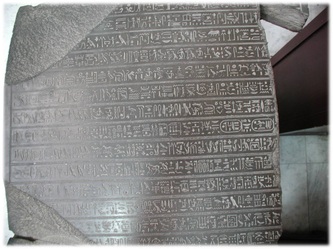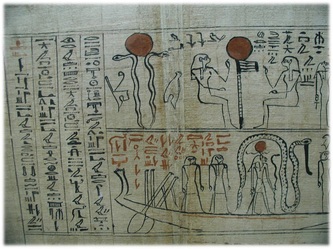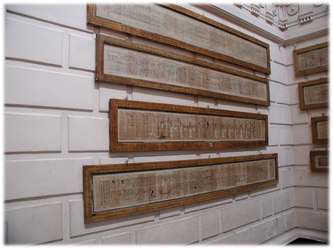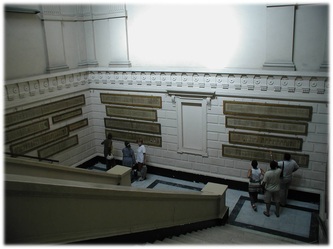ORIGIN OF THE WRITTEN TEXT
The pictures above are images of early writings. This begs the question...
How Was the Bible Written?
Materials Used
Papyrus
Reeds stripped, cut, beaten, pressed and polished
Sent through “Byblos”, a Syrian port
Oldest fragment = 2,400 B.C.
Used until 3rd Century A.D. Parchment
Animal skin (sheep, goat, antelope, etc.)
Associated with Pergamum, Asia Minor
Vellum
Calf skin cleaned, bleached, scrapped, stretched.
Ostraca
Common unglazed pottery (broken pieces used as voting ballots to “ostracize” someone in a pure democracy)
Stones
Clay tablets
Wax tablets
Flat wood covered with wax
Papyrus
Reeds stripped, cut, beaten, pressed and polished
Sent through “Byblos”, a Syrian port
Oldest fragment = 2,400 B.C.
Used until 3rd Century A.D. Parchment
Animal skin (sheep, goat, antelope, etc.)
Associated with Pergamum, Asia Minor
Vellum
Calf skin cleaned, bleached, scrapped, stretched.
Ostraca
Common unglazed pottery (broken pieces used as voting ballots to “ostracize” someone in a pure democracy)
Stones
Clay tablets
Wax tablets
Flat wood covered with wax
Writing Instruments
Chisel
Metal Stylus
Pen
Pointed reed
Used on vellum, parchment, papyrus
Ink
Charcoal, gum, and water edit.
Metal Stylus
Pen
Pointed reed
Used on vellum, parchment, papyrus
Ink
Charcoal, gum, and water edit.
Forms of Ancient Books
Scrolls
Sheets of papyrus glued together
Longest = 144 feet
“A big book is a big nuisance.” -Callimachus
Codex (“book”)
Leaf form, written on both sides
Spread of Christianity the main reason?
Sheets of papyrus glued together
Longest = 144 feet
“A big book is a big nuisance.” -Callimachus
Codex (“book”)
Leaf form, written on both sides
Spread of Christianity the main reason?
Types of Writing
Uncial writing
Deliberate, careful, separate letters
Codex Vaticanus (325 – 350 A.D.)
Codex Sinaiticus (340 A.D.)
Miniscule writing
Smaller letters, connected, continuous
Used for books (9th Century A.D.)
Deliberate, careful, separate letters
Codex Vaticanus (325 – 350 A.D.)
Codex Sinaiticus (340 A.D.)
Miniscule writing
Smaller letters, connected, continuous
Used for books (9th Century A.D.)
Spaces and Vowels
Greek
Nobreaksbetweenwords (scriptio continua)
All words ended in vowels or one of three consonants (ν,ρ,ς) so were easy to read.
Hebrew
Vowels not written until 5th - 10th Century A.D. by the Massoretes
Nobreaksbetweenwords (scriptio continua)
All words ended in vowels or one of three consonants (ν,ρ,ς) so were easy to read.
Hebrew
Vowels not written until 5th - 10th Century A.D. by the Massoretes
Divisions of the Text
Old Testament
Before 586 B.C. prior to 1st Babylonian Captivity
Pentateuch
Sedarium = 154 sections = 3 yr. cycle of reading
Before 536 B.C. (Babylon)
Pentateuch
Parashiyyoth = 54 sections then subdivided into 669 sections for easier reference, single year reading cycle.
Around 165 B.C....Books called “the Prophets”sectioned
After Protestant Reformation....Divisions in margins in 1330 A.D.
New Testament
Paragraphs Before Council of Nicaea (325 A.D)
Chapters...350 A.D.– in the margins of Codex Vaticanus...Matthew had 170 sections
1227 A.D.– Current chapter divisions by Stephen Langton Professor at University of Paris...Later The Archbishop of Canterbury
Before 586 B.C. prior to 1st Babylonian Captivity
Pentateuch
Sedarium = 154 sections = 3 yr. cycle of reading
Before 536 B.C. (Babylon)
Pentateuch
Parashiyyoth = 54 sections then subdivided into 669 sections for easier reference, single year reading cycle.
Around 165 B.C....Books called “the Prophets”sectioned
After Protestant Reformation....Divisions in margins in 1330 A.D.
New Testament
Paragraphs Before Council of Nicaea (325 A.D)
Chapters...350 A.D.– in the margins of Codex Vaticanus...Matthew had 170 sections
1227 A.D.– Current chapter divisions by Stephen Langton Professor at University of Paris...Later The Archbishop of Canterbury
Verses
Old Testament
First verse indicators: spaces between words that previouslyweretogetherlikethis
Space stops after Babylonian captivity –“verse markings” not standardized until 900 A.D.
First verse indicators: spaces between words that previouslyweretogetherlikethis
Space stops after Babylonian captivity –“verse markings” not standardized until 900 A.D.
Oral Tradition
Papias (~130 A.D.)...Interested in texts, but demonstrates that oral tradition is still “king” at this time “I did not think that information from books would help me so much as a living and surviving voice.” No surviving works. Fragments recorded by Eusebius. “Expositions of the Sayings of the Lord”. Collection of sayings he had heard from ‘students of elders who claimed to have known the first disciples’.
Polycarp (~130 A.D.)
A single letter of quotes attributed to Jesus
Roughly 100 quotes
Some match gospel quotes
Some match non-Jesus statements from epistles
Cites no sources
Polycarp (~130 A.D.)
A single letter of quotes attributed to Jesus
Roughly 100 quotes
Some match gospel quotes
Some match non-Jesus statements from epistles
Cites no sources
Written Tradition Begins
Basilides(~135 A.D.)
Gnostic
Composed the ‘Exegetica’
Commentary on Gospel story
Unknown whether he used oral or written sources
Considered heretical
Until this point, the only authority cited was “Jesus” or “Christ”
Basilides ‘Exegetica’ started the doctrinal battles.
Essentially drawing a line in the sand, implying that you either agreed with him or you’re a heretic.
The need to establish Church authority to dictate or preserve doctrine was beginning.
Paul vs. the Jewish Christians
We see some of this in the varying doctrines expressed in the New Testament.
Some of the disagreements are catalogued in the Bible (Acts)
Romans vs. Jews
Pressure on Christians (echoing this Pauline conflict)
Began the “us and them” claims
Pro-Roman, Anti-Jew doctrines become popular
Marcion (~144 A.D.)
Proposes a reform of Christianity
Old Testament is contradictory and barbaric
Only Paul’s writings are true
The true writings weren’t Jewish
Expelled from the church and formed his own
Gnostic beliefs
Jesus wasn’t human
No Hell
Established the first Canon...10 Epistles and one Gospel
Gospel later identified by Tertullian as that of Luke, but with the nativity and all Old Testament references removed
Commentary retained
Written prefaces used for the Latin Vulgate
Montanism (~156 A.D.)
Similar to Protestant (Pentecostal) movement
Speaking in tongues
Individual interpretation
Non-clerical authority
Made the common man as good as a Priest
Apocalyptic movement
Eventually leads to the conflict over canonizing the Revelation of John
Gnostic
Composed the ‘Exegetica’
Commentary on Gospel story
Unknown whether he used oral or written sources
Considered heretical
Until this point, the only authority cited was “Jesus” or “Christ”
Basilides ‘Exegetica’ started the doctrinal battles.
Essentially drawing a line in the sand, implying that you either agreed with him or you’re a heretic.
The need to establish Church authority to dictate or preserve doctrine was beginning.
Paul vs. the Jewish Christians
We see some of this in the varying doctrines expressed in the New Testament.
Some of the disagreements are catalogued in the Bible (Acts)
Romans vs. Jews
Pressure on Christians (echoing this Pauline conflict)
Began the “us and them” claims
Pro-Roman, Anti-Jew doctrines become popular
Marcion (~144 A.D.)
Proposes a reform of Christianity
Old Testament is contradictory and barbaric
Only Paul’s writings are true
The true writings weren’t Jewish
Expelled from the church and formed his own
Gnostic beliefs
Jesus wasn’t human
No Hell
Established the first Canon...10 Epistles and one Gospel
Gospel later identified by Tertullian as that of Luke, but with the nativity and all Old Testament references removed
Commentary retained
Written prefaces used for the Latin Vulgate
Montanism (~156 A.D.)
Similar to Protestant (Pentecostal) movement
Speaking in tongues
Individual interpretation
Non-clerical authority
Made the common man as good as a Priest
Apocalyptic movement
Eventually leads to the conflict over canonizing the Revelation of John
Doctrinal Politics
Church authority
Can’t have the average Joe reading and interpreting things on his own
Travel issues
People stayed close to home
Occasional travelers would discover differences in doctrine and write back to the ‘mother’ church
Church dispatches
Priests would travel and ‘review’churches to determine if their doctrine was sound.
Build a base
The older, more powerful, richer or stronger-willed churches would dictate doctrine to outlying churches
Those who went along were rewarded
Despite Marcion’scanon, the Montanism heresy and the doctrinal issues, there is still no attempt to create an orthodox canon at this time (~175 A.D.).
Can’t have the average Joe reading and interpreting things on his own
Travel issues
People stayed close to home
Occasional travelers would discover differences in doctrine and write back to the ‘mother’ church
Church dispatches
Priests would travel and ‘review’churches to determine if their doctrine was sound.
Build a base
The older, more powerful, richer or stronger-willed churches would dictate doctrine to outlying churches
Those who went along were rewarded
Despite Marcion’scanon, the Montanism heresy and the doctrinal issues, there is still no attempt to create an orthodox canon at this time (~175 A.D.).




